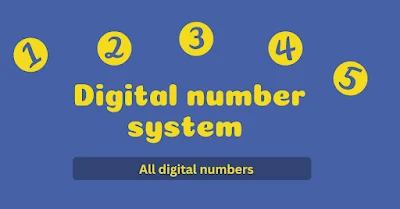A digital number system is a way of representing numbers using digits, usually in the base of 2 (binary), 10 (decimal), or 16 (hexadecimal). These number systems are used in various fields such as computer science, electronics, and mathematics. The most common digital number systems are binary (base 2), decimal (base 10), and hexadecimal (base 16). In this article, we will discuss these number systems in detail.
Binary (base 2) is the foundation of computer architecture and is used to represent all data stored and processed in a computer. It uses only two digits, 0 and 1, to represent numbers. In the binary system, each digit represents a power of 2. For example, the binary number 1001 represents the decimal value of 12^3 + 02^2 + 02^1 + 12^0 = 8 + 1 = 9.
Binary numbers are used in a variety of applications, including computer memory and storage, digital logic, and data transmission. They are also used to represent the state of electronic devices such as switches, transistors, and diodes. In a computer, a binary number is used to represent a single bit (binary digit) of data, which can have a value of either 0 or 1.
Decimal (base 10) is the number system most commonly used in everyday life. It uses ten digits, 0 through 9, to represent numbers. In the decimal system, each digit represents a power of 10. For example, the decimal number 123 represents the value of 110^2 + 210^1 + 3*10^0 = 100 + 20 + 3 = 123.
Decimal numbers are used in various applications such as financial transactions, measurements, and scientific calculations. They are also used in computer programming, where decimal numbers are often used to represent the values of variables and constants.
Hexadecimal (base 16) is commonly used in computer programming and is a more compact way to represent binary numbers. It uses sixteen digits, 0 through 9 and A through F. In the hexadecimal system, each digit represents a power of 16. For example, the hexadecimal number A3 represents the decimal value of 1016^1 + 316^0 = 160 + 3 = 163.
Hexadecimal numbers are often used in computer programming to represent large binary numbers in a more compact form. They are also used to represent color values in web design and to specify memory addresses in computer memory.
In addition to these three number systems, there is also an Octal number system which uses base 8 and uses digits from 0 to 7.
Digital systems can also be used to represent negative numbers by using a technique called two's complement representation. This method is used in computers to represent signed integers. The two's complement of a binary number is the value obtained by inverting all the bits (changing 0s to 1s and vice versa) and then adding 1 to the result. Negative numbers are represented using the two's complement notation and positive numbers are represented using the regular binary notation.
In conclusion, digital number systems are an essential aspect of computer science and electronics. They are used to represent numbers in a compact and efficient manner. Each number system has its own unique properties and uses and it is important to understand the basics of each number system in order to effectively use them in different applications.

